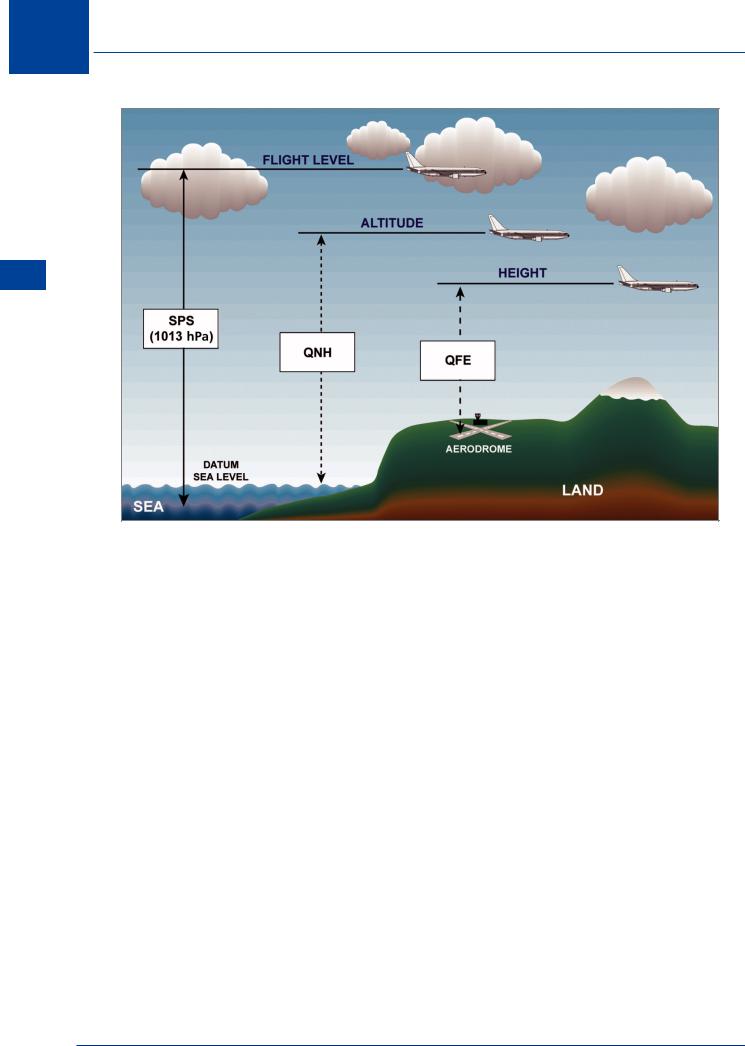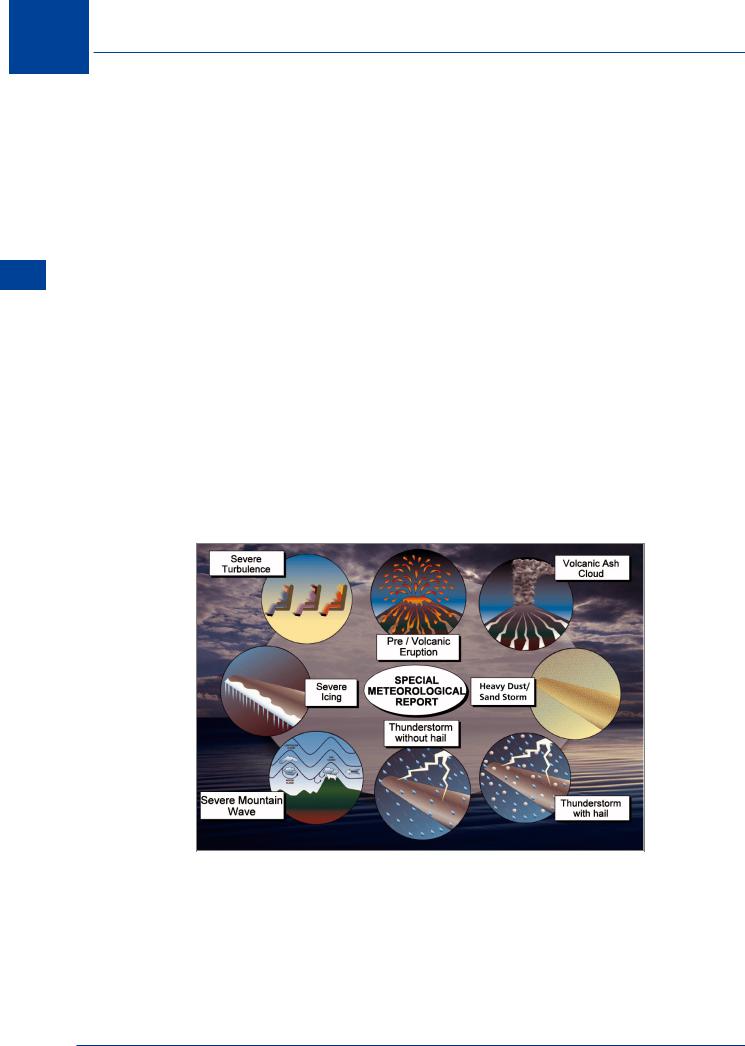
- •Textbook Series
- •Contents
- •ATPL Book 14 Communications
- •1 Definitions
- •Introduction
- •Transmission of Letters and Numbers
- •Definitions
- •Abbreviations
- •Categories of Messages
- •VHF Range
- •2 General Operating Procedures
- •Introduction
- •Technique
- •Transmission of Time
- •Standard Words and Phrases
- •Call Signs
- •Direction Finding (DF)
- •Radio Test Procedures
- •Transfer of Communications
- •Readback
- •Radar Procedures
- •Conditional Clearances
- •3 Phraseology
- •Introduction
- •General Phraseology
- •Area Control Services
- •Approach Control Services
- •Starting Procedures
- •Coordination between ATS Units
- •General Radar Phraseologies
- •Radar in Approach Control Service
- •Surveillance Radar Approach
- •PAR Approach
- •SSR Phraseology
- •8.33 kHz Phraseology
- •Initial Message
- •4 Weather Information
- •Introduction
- •Sources of Weather Information
- •Supplementary Information
- •5 Failures and Emergencies
- •Introduction
- •Communications Failure
- •Emergencies
- •Distress Procedures
- •Urgency Procedures
- •Medical Transports
- •Communications Related to Acts of Unlawful Interference
- •Introduction
- •Call Signs
- •Level Reporting
- •Position Reporting
- •MET Reports
- •Communication Failure under IFR
- •SELCAL
- •NDB Approach Profiles
- •7 VHF Propagation
- •Introduction
- •Radio Frequency Bands
- •VHF Frequency Spread
- •VHF Frequency Separation
- •VHF Propagation Characteristics
- •Factors Affecting VHF Propagation
- •Effective Range of VHF
- •Freak Propagation
- •8 Questions
- •Specimen Questions – IFR
- •9 Index

IFR 6
Introduction
The procedures for IFR and VFR are mostly identical, but some words and procedures are generally only used by large commercial aircraft; hence they appear in this section.
In this chapter, we will discuss the remaining elements of communications which apply to IFR flight, rather than to both VFR and IFR.
Call Signs
‘HEAVY’
Aircraft which are in the heavy wake turbulence category must use the word ‘HEAVY’ in the initial call to an ATSU (Air Traffic Service Unit).
Note: wake turbulence categories are normally determined by maximum certified take-off weight, with HEAVY being greater than 136 000 kg.
“Brize Radar, Speedbird 213 Heavy, request radar advisory”
Change Call Sign
In the interests of safety, an aeronautical station (ATC) may tell an aircraft to change call sign temporarily. The aircraft station cannot do this! For example, there may be two aircraft on the same frequency with a similar sounding call sign: Speedbird 123 and Birdseed 123.
“Speedbird 123 change call sign to BA 123”
When this is no longer required (one aircraft has left frequency or the subject aircraft is handed over to another agency for example), the aircraft is told to revert to its original call sign.
“BA123 revert to flight plan call sign”
Level Reporting
Vertical Position
The reporting of vertical position aircraft depends upon the altimeter pressure setting in use.
Standard Pressure Setting (SPS)
Its reading is based on sea level pressure in the standard atmosphere i.e. 1013 hPa. The altimeter reads FLIGHT LEVEL.
Note: SPS does not read height above sea level, but merely above a standard datum.
QNH
With this pressure setting, the altimeter reads ALTITUDE above mean sea level for the actual atmospheric conditions.
QFE
With this pressure setting, the altimeter reads HEIGHT, usually above the runway threshold. (Commercial operations rarely use this pressure setting now.)
Levels may be reported as Altitude, Height or Flight Level, according to the phase of flight and the altimeter setting; with the SPS set, the words ‘Flight Level’ must be used prior to the given level.
IFR 6
121

6 IFR
IFR 6
Figure 6.1 Pressure settings
Examples
In the following examples ‘climb’ or ‘descend’ are interchangeable.
Event |
ATC |
Pilot |
|
|
|
|
|
|
|
Flight Level change |
Fastair 243 |
Descend to FL120 |
Fastair |
|
Descend to FL120 |
243 |
|
||
|
|
|||
|
|
|
|
|
Flight Level change |
Fastair 243 |
Recleared FL60 |
Fastair |
|
Recleared FL60 |
243 |
|
||
|
|
|||
|
|
|
|
|
|
Fastair 243 |
QNH 1003 Descend to |
||
Altitude |
Set QNH 1003 Descend to |
|||
3000 ft Fastair 243 |
||||
|
3000 ft |
|||
|
|
|
||
Inability to climb |
Fastair 243 |
Fastair 243 |
||
Expedite climb to FL200 |
Unable due to weight |
|||
|
||||
|
|
|
|
|
122

IFR 6
Position Reporting
Compulsory Position Reports
Compulsory position reports may be required on some routes that may or may not have designated significant points. These reports shall contain the following elements of information, except that elements 4, 5 and 6 may be omitted under certain conditions:
1.call sign
2.position
3.time
4.level
5.next position and time
6.ensuing significant point
Note: 1,2 and 3 may not be omitted.
Exemptions
Where adequate flight progress data is available from other sources, such as surveillance radar, flights may exempted from compulsory position reports. Examples of messages relating to such exemption include:
“FASTAIR 345 NEXT REPORT COLINTON ”
“FASTAIR 345 OMIT POSITION REPORTS UNTIL FIR BOUNDARY, NEXT REPORT COLINTON ”
“FASTAIR 345 RESUME POSITION REPORTING ”
The reply to such a message would be:
“ FASTAIR 345 WILCO ”
MET Reports
Requirement
Occasionally aircraft meteorological observations are required. (In practice, these are rarely required in the UK, but in some areas where observations are difficult [e.g. the Atlantic], aircraft reports are valuable). The reports required are:
•routine aircraft observations during en route and climb out phases.
•special reports during any phase of flight.
The following flights are exempt from sending met reports:
•aircraft not equipped with RNAV (area navigation)
•flight is less than 2 hours
•aircraft is less than 1 hour from next landing
•altitude of flight is less than 1500 m (5000 ft)
IFR 6
123

6 IFR
IFR 6
Content of Routine Met Reports
The content of a routine report is combined with a routine position report as shown below:
SECTION 1 (POSITION)
Call sign, Position, Time, Level, Next Position & ETA
SECTION 2 (OPERATIONAL INFO)
ETA (at destination), Endurance
SECTION 3 (MET INFO)
Air Temp, Wind (direction and speed), Turbulence, Icing, Humidity
Special Met Reports
The content of a special met report includes:
SECTION 1 Call sign, Position, Time Level
SECTION 2 Special met condition
Special reports are reported in SPECIAL weather conditions such as Severe Turbulence, Volcanic Ash, Pre-volcanic Eruption, Severe Icing, Heavy Dust/Sand Storm, Thunderstorm, Severe Mountain Wave.
Figure 6.2 Special weather conditions
124
